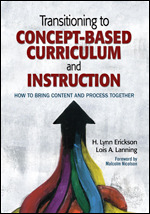Transitioning to Concept-Based Curriculum and Instruction
How to Bring Content and Process Together
- H. Lynn Erickson - Educational Consultant, Everett, WA
- Lois A. Lanning - Educational Consultant, Connecticut
Foreword by Malcolm Nicolson
A cutting-edge model for 21st century curriculum and instruction
How can you spot a thinking child? Look at the eyes: they’ll light up, signaling that transformative moment when your student has finally grasped that big idea behind critical academic content. If experiences like this are all too rare in your school, then you need a curriculum and instruction model that’s more inquiry-driven and idea-centered. Now.
H. Lynn Erickson and Lois Lanning demonstrate how, through concept-based curriculum, you can move beyond superficial coverage and lower-level skills practice to effect intellectually engaging pedagogy, where students engage in problem finding and problem solving. New insights include:
- How to design and implement concept-based curriculum and instruction across all subjects and grade levels.
- Why content and process are two different (but equally important) aspects of any effective concept-based curriculum.
- How to ensure students develop the all-important skill of synergistic thinking.
We’re all looking for the best curriculum and instruction model to meet the changing demands of the 21st century. This is it.
"With the onset of the Common Core and new national content standards, concept-based learning is now more crucial than ever. Erickson and Lanning are 'ahead of the curve' in providing teachers and curriculum leaders with rich instructional strategies to meet these challenging standards. This is an essential book for planning tomorrow’s curricula today."
Douglas Llewellyn, Educational Consultant and Author of Inquire Within, Third Edition
"Powerful teaching engages minds with powerful ideas. At its core, such transformative teaching is neither transmission of information nor practice with inert skills. Rather it is a careful choreography between a mind and an idea such that the mind comes to own the idea in a form that is true to the discipline and expansive for the learner. Erickson and Lanning teach teachers to be choreographers of learning—understanding both what makes content worth knowing and how to engage young minds with that content in ways that extend their capacities to understand it at a deeper level, use it, transfer it, and ultimately create with it."
Carol Ann Tomlinson, Ed.D., Chair of Educational Leadership, Foundations, and Policy
Curry School of Education, University of Virginia
"With the onset of the Common Core and new national content standards, concept-based learning is now more crucial than ever. Erickson and Lanning are “ahead of the curve” in providing teachers and curriculum leaders with rich instructional strategies to meet these challenging standards. This is an essential book for planning tomorrow’s curricula today."
"Powerful teaching engages minds with powerful ideas. At its core, such transformative teaching is neither transmission of information nor practice with inert skills. Rather it is a careful choreography between a mind and an idea such that the mind comes to own the idea in a form that is true to the discipline and expansive for the learner. Erickson and Lanning teach teachers to be choreographers of learning—understanding both what makes content worth knowing and how to engage young minds with that content in ways that extend their capacities to understand it at a deep level, use it, transfer it, and ultimately create with it."
"As educators we all think we understand concept-based curriculum, but those who read this text will have a comprehensive understanding of the meaning and value of concept-based curriculum. This text clearly explains concept-based teaching for the educator to use and develop a change in their teaching to effectively reach and engage students in critical thinking that will enable them to be productive citizens and lifelong learners."
"High school department heads take notice! You will want to read this book with your curriculum supervisor and with your teachers before you re-design your courses to align with the aspirations of the CCSS and NGSS. The curriculum model and specific examples in this book provide you with a clear guide for designing complex, intellectually stimulating curriculum while integrating the new standards."
"Providing today’s students with the skills to become critical, analytical, and life-long learners is an obligation each teacher must make. The authors present a clear path to transition from fact-based learning curriculum to concept-based curriculum. They have provided us with a clear, researched-based approach to help us advocate at our school and district level to make this critical change in curriculum."
Sample Materials & Chapters
Transitioning to Concept-Based Curriculum and Instruction - Front Matter
Transitioning to Concept-Based Curriculum and Instruction - P. 10-13
Transitioning to Concept-Based Curriculum and Instruction - P. 22-27
Transitioning to Concept-Based Curriculum and Instruction - P. 57-60
Transitioning to Concept-Based Curriculum and Instruction - P. 83-87
